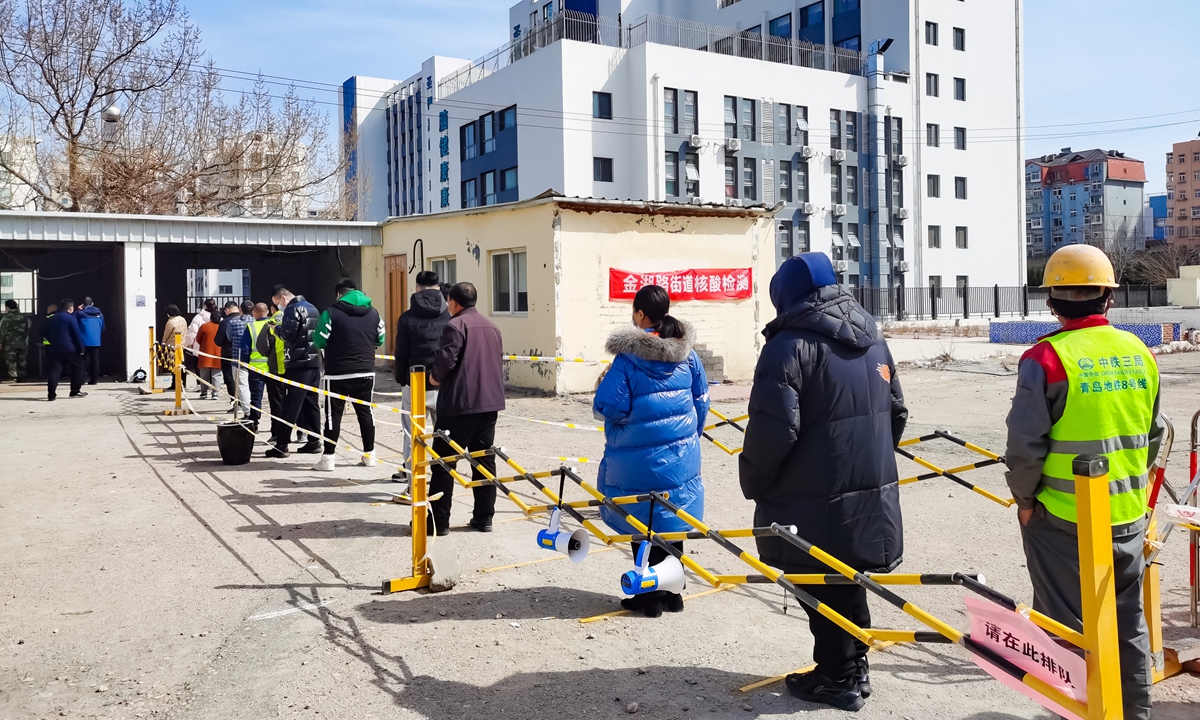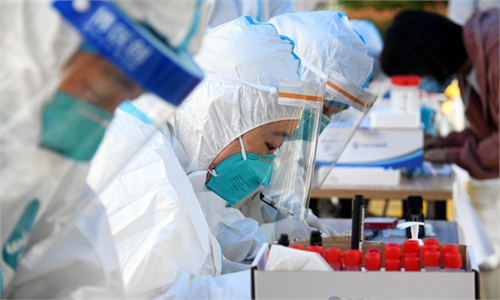Confirmed cases across China exceed 100, strict dynamic zero-COVID approach 'still necessary'

People who have visited Laixi, East China's Shandong Province, and those who had contact with people from Laixi queue to receive nucleic acid testing on March 6, 2022 in Qingdao, Shandong. Shandong reported 88 cases as of the end of Saturday. Photo: VCG
The Chinese National Health Commission announced on Sunday that as of the end of Saturday, 175 local cases had been reported during the latest sporadic outbreak, including 88 in Qingdao, East China's Shandong Province. Experts noted that although the epidemic has broken out in multiple locations and the situation is quite severe, China still has the ability to control it following the strict dynamic zero-COVID policy.
As of Saturday, a total of 91 confirmed COVID-19 cases had been reported in Laixi, a city under the administration of Qingdao, including 78 students, nine teachers, and four cases screened in the key population. Medical experts have diagnosed all cases as mild.
According to a press conference held on Sunday, the genetic sequencing of the current outbreak in Laixi, Qingdao, showed that the virus belongs to the Omicron variant, and the sources of cases there are different from those of the current cases in other areas of China and imported cases. The possibility of an association with the previous cases in Huangdao district, Qingdao has been ruled out, and the main risk source of Laixi has been cut off.
The Qingdao health department announced on Sunday that the cases reported in Huangdao were caused by the infection of people who had contact with goods with Omicron virus from affected areas in other provinces. The district reported two new COVID-19 cases on Friday, according to the latest information from the health department.
Some Chinese experts believe that the latest outbreak in China is related to the rampant international pandemic with the new variant of Omicron. "Now is not the right time to relax our epidemic control measures, considering the severe pandemic. Also, as the spring approaches, respiratory infections are still in an active period," Wang Guangfa, a respiratory expert at Peking University First Hospital, who was also among the experts of the National Health Commission who visited Wuhan in January 2020, told the Global Times on Sunday.
"Hopefully, when the epidemic abroad ebbs significantly and the vaccination rate in China reaches a very high level, the pressure on epidemic control and the dynamic zero-COVID policy could be eased," Wang explained.
Faced with sporadic outbreaks in China, experts differed on whether this winter will be the last one associated with COVID-19.
In an interview with China's state broadcaster CCTV in January, Zhang Wenhong, a well-respected infectious disease expert in Shanghai, said this season may be the "last cold winter" China will experience during its COVID-19 fight, following the increasing herd immunity level and the new drugs.
But Gao Fu, director of the Chinese Center for Disease Control and Prevention, said on Sunday that it is still too early to say that the winter of 2021 will be the last winter associated with the novel coronavirus.
In an interview with China News Service on Sunday, Gao, who is also a member of the National Committee of the Chinese People's Political Consultative Conference, said that this deduction may be mainly based on the increased transmission power but the reduced virulence of the Omicron variant, which is an ideal state. But Gao noted that "the real numbers (of cases) don't tell us that it [the virulence of Omicron] has subsided to a level lower than the flu."
Given that the virus is changing and adapting to humans, Gao said that "I don't think we are at the point where we can predict that after this winter, the virus will be acceptable to human society."
When asked whether a fourth or fifth shot is needed after the booster shot, Gao said that "future vaccination strategies for COVID-19 will be based on the characteristics of the virus, the prevalence of the disease, the characteristics of the vaccine and so on."


